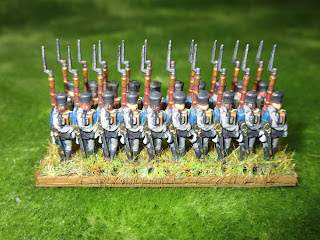I know it's total madness, but one that afflicts many of us. This being the covering of the same period of history, but in several different scales!
My recent posts were of my 28mm Peninsular troops but there is something appealing about the massed ranks of close order infantry that are the Warlord Games Epic scale troops.
I do have quite a number of the old Minifigs 15mm figures and they do have that wonderful classic look to them, but they would still require individually gluing very close together to achieve anything like as good as the look of the close order Epic figures and even then I don't think they would pull it off.
The other great bonus of these troops is their comparatively low purchase price and also the speed of painting that their pre-cast formation lends itself to.
I was able to base airbrush the entire Prussian Brigade box set with some care and paint top ups, in about 10 to 15 minutes.
I took about 3 extended evenings to paint these plus one more for basing. As it's not the whole figure being painted, doing 80 of these is not too tedious a job.
The casting is very crisp and the detail nicely prominent. This lent itself to painting very well, but also encouraged me to put more detail in than I intended!
I have a particular project in mind with these and that is the recreation of the Plancenoit battle. This scale should mean I that I can get most of the battlefield on my 8 x 4 table (I hope).
For my first Prussian unit, I really fancied painting one with red cuffs and collars. There seemed to be a variety of red shades used, so there seemed to me to be a good chance of finding one in IV Corps who was there at Plancenoit. I merrily applied base colours and continued my research.
To my surprise no units in IV Corps had red collars and cuffs that I could find! However I did find that the 25 Infantry Regiment of 5 Brigade in II Corps were heavily engaged at Plancenoit also. I thought this was my answer so continued to paint whilst still researching. Then I found that it appears that only the 3rd (Fusilier) Battalion of that Regiment wore the blue tunic, the remainder (the 1st and 2nd Battalions) appear in the sources that I found, to be wearing the long black coats and black trousers.
This left me with a hard choice - Do I now go back and change the red to another colour and change the regiment? Or do I cut down the flag staff, turn it into a musket and continue down the Fusilier route?
I chose the latter. One thing I didn't do was replace the drum with a home made bugle. That would have involved more carving skill (and time) than I possess. They will have to be happy with the drum.
Hopefully the converted flagpole, now a musket with bayonet, is not too obvious a conversion. I cut down a 28mm sword to make the bayonet for it and re-shaped it.
These were fun to paint. I think if I had stopped or been interrupted for long I would have lost interest in completing them, as I do find figures smaller than 28mm a lot less rewarding to paint. However, I am pleased with these and will continue to do units every so often.
Now to get back to the Anglo-Saxon warriors who have been sat patiently on my desk whilst I did my 'Epic' try out!












Great work Jason and I can see the appeal of the Epic figures. Did the Prussian fusiliers at Waterloo not have drummers and carry a standard? The red against the blue is a lovely combination and really stands out at this scale.
ReplyDeleteHi Lawrence, my reading of the Prussian army (and I admit it's limited so far for Waterloo) is that only the 1st and 2nd Battalions had standards and had drummers and Fusiliers had horns. My reference so far are the illustrations on Mont St Jean website for the horn. I'm trying to find the reference for the standards. I'm very happy to be corrected if my info is off target: https://centjours.mont-saint-jean.com/detail_uniformes_unitePR.php?nom=F%C3%BCsilier-Batallion%20des%20Infanterie-Regiment%20Nr.25&rubrique=U&uniformes=72&drapeau=
DeleteHello again Lawrence, I found my source about flags and fusilier battalions. It is 'Flags and Standards of the Napoleonic Wars' by Keith Over (Published 1976). He says 'The 1807 instructions called for 2 flags per musketeer battalion, but no flags for fusiliers or grenadiers. Grenadier formations were carrying flags by 1812 but fusiliers (with the exception of the fusiliers of guard grenadier units who received flags in 1814) did not get flags until after the wars in 1815.' I'm glad I don't have to stick a flag back on my fusilier standard bearer again! :-D
DeleteIt IS total madness, of course, as you rightly say, Jason - but as you also correctly state, a madness that affects many of us - personally, I have WWII Brits, Germans and Russians in 15mm, 20mm AND 28mm!
ReplyDeleteI can definitely see the appeal of the Epic ranges, although now I have tried 10mm via the Cromarty Forge 3d printed figures, I would probably be tempted to go there - or possibly even as small as 6mm, for an era with large, formal formations such as the 17th - mid 19th centuries.....not saying I am actively considering anything like that....but never say never!
I've been looking at 2mm figures to use with the 'Blucher' rules this week too! Craziness on my part - though it is all good fun too! :-)
DeleteYes you're insane, apart from that they're splendid!
ReplyDeleteBest Iain
Thanks Iain, I'm back on to 28mm again but will return to do an occasional battalion of Epic scale between other projects, I think.
DeleteBest wishes,
Jason